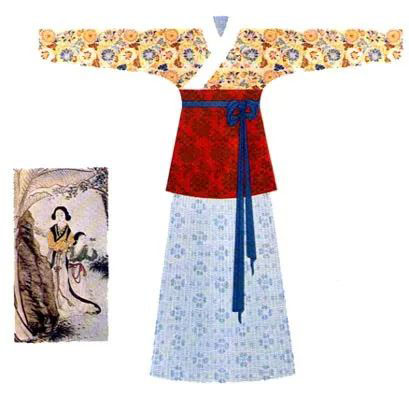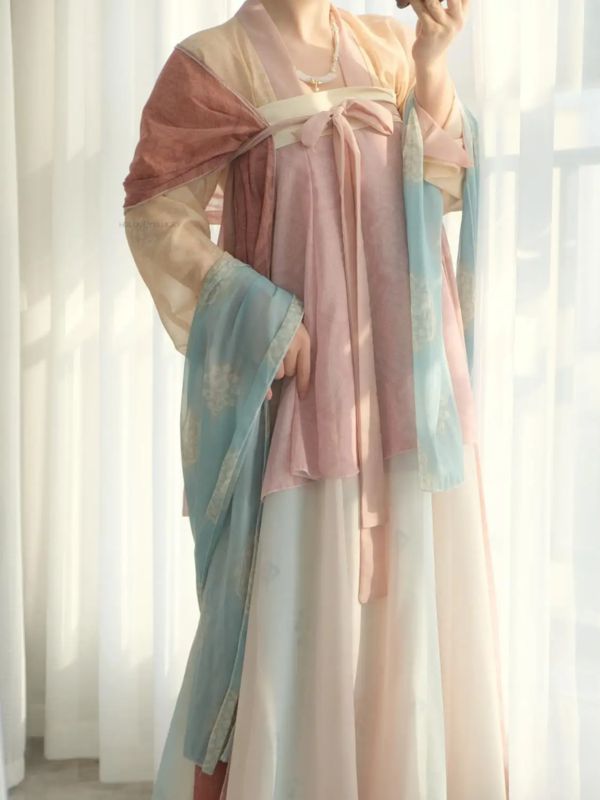Yaoqun: The Intricate Art of Hanfu Embroidery
Yaoqun, an intricate and time-honored art form, is an integral part of Hanfu, the traditional clothing of the Han Chinese. This exquisite embroidery technique involves meticulously stitching intricate designs onto fabric, creating vibrant and captivating patterns that adorn the garments.

The origins of Yaoqun can be traced back to ancient China, where it was initially used to embellish imperial robes and ceremonial attire. Over time, it became more widely adopted, adorning the clothing of both men and women from all walks of life. The designs employed in Yaoqun are often inspired by nature, featuring motifs such as flowers, birds, and animals. These motifs are rendered with exceptional detail and precision, showcasing the skill and artistry of the embroiderers.
The process of creating Yaoqun is both complex and time-consuming. It begins with the selection of high-quality fabrics, such as silk or satin, which provide a smooth and durable base for the embroidery. The designs are then carefully sketched onto the fabric, and the embroiderers use a variety of stitches to bring them to life. These stitches include satin stitch, chain stitch, and French knot, each contributing to the unique texture and depth of the embroidery.

The colors used in Yaoqun are typically vibrant and eye-catching, with a wide range of hues employed to create harmonious and visually appealing patterns. The embroiderers often use multiple strands of thread to achieve a rich and lustrous effect, adding to the overall opulence of the garments.
Yaoqun is not merely a decorative element; it also holds cultural and symbolic significance. The motifs and designs used in the embroidery often carry specific meanings, representing auspicious wishes, blessings, or virtues. For example, the peony flower symbolizes wealth and prosperity, while the phoenix represents longevity and good fortune.
In contemporary times, Yaoqun continues to be highly valued and appreciated. It is often used to adorn special occasion garments, such as wedding dresses and formal attire. Additionally, Yaoqun has gained recognition as a form of artistic expression, with exhibitions and workshops showcasing the skill and creativity of modern embroiderers.
Preserving and promoting Yaoqun is essential for safeguarding China’s rich cultural heritage. By supporting and encouraging the work of skilled embroiderers, we can ensure that this intricate art form continues to flourish for generations to come.
Exploring the Symbolism and History of Yaoqun in Hanfu
Yaoqun, an integral component of Hanfu, the traditional attire of the Han Chinese, holds profound cultural and historical significance. It is a long, flowing skirt that extends from the waist to the ankles, typically made from lightweight fabrics such as silk or gauze.

The origins of Yaoqun can be traced back to ancient China, where it was worn by both men and women. During the Han Dynasty (206 BCE – 220 CE), Yaoqun became a popular garment among the elite, symbolizing elegance and refinement. Over time, it evolved into a predominantly feminine garment, associated with grace and modesty.
The symbolism of Yaoqun is deeply rooted in Chinese culture. Its flowing lines represent the fluidity of water, a symbol of purity and tranquility. The length of the skirt signifies modesty and humility, while the lightweight fabrics evoke a sense of ethereal beauty.
In addition to its symbolic meaning, Yaoqun also serves a practical purpose. Its loose and airy design allows for freedom of movement, making it suitable for various activities such as dancing, walking, and everyday wear. The lightweight fabrics provide comfort and breathability, especially during the warm summer months.

Throughout history, Yaoqun has undergone various changes in style and design. During the Tang Dynasty (618 – 907 CE), it was often paired with a short jacket called a “beizi” and adorned with intricate embroidery. In the Song Dynasty (960 – 1279 CE), Yaoqun became more elaborate, featuring multiple layers and decorative trims.
In modern times, Yaoqun has experienced a resurgence in popularity as part of the Hanfu revival movement. It is now worn by people of all ages and backgrounds, both in China and abroad. The revival of Yaoqun not only preserves a piece of Chinese cultural heritage but also promotes a sense of national pride and identity.
In conclusion, Yaoqun is a multifaceted garment that embodies the rich symbolism and history of Hanfu. Its flowing lines, modest length, and lightweight fabrics represent purity, grace, and practicality. As a symbol of Chinese culture, Yaoqun continues to be cherished and celebrated, both as a historical artifact and a contemporary fashion statement.
A Guide to the Different Types of Yaoqun in Hanfu
Yaoqun, an integral component of Hanfu, the traditional attire of the Han Chinese, holds significant cultural and historical value. It refers to the outer skirt worn over the inner skirt, known as the qun. Yaoqun come in various styles, each with unique characteristics and purposes.

The most common type of Yaoqun is the mawei yaoqun, characterized by its pleated design. The pleats, known as mawei, create a flowing and elegant silhouette. Mawei yaoqun are often made from lightweight fabrics such as silk or gauze, making them suitable for both formal and casual occasions.

Another popular style is the qixiong yaoqun, which features seven panels of fabric sewn together. The panels are often decorated with intricate embroidery or patterns, adding a touch of opulence to the garment. Qixiong yaoqun are typically worn for special occasions or formal gatherings.
For colder weather, the mianfu yaoqun is an ideal choice. Made from thicker fabrics such as wool or cotton, it provides warmth and insulation. Mianfu yaoqun often have a longer length and may be lined with fur or other materials for added comfort.
The duijin yaoqun is a unique style that is worn by wrapping two panels of fabric around the waist and securing them with a belt. This type of yaoqun allows for greater freedom of movement and is often worn for activities such as dancing or martial arts.
In addition to these main styles, there are numerous other variations of Yaoqun, each with its own distinct features. Some yaoqun may have asymmetrical designs, while others may incorporate different types of fabrics or embellishments. The choice of Yaoqun depends on the wearer’s personal preferences, the occasion, and the overall style of the Hanfu ensemble.
Yaoqun plays a crucial role in completing the Hanfu attire. They add volume, movement, and visual interest to the garment. The different styles and designs of Yaoqun allow individuals to express their creativity and showcase their appreciation for Chinese cultural heritage.
